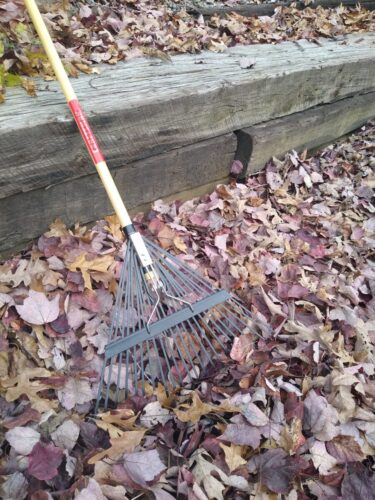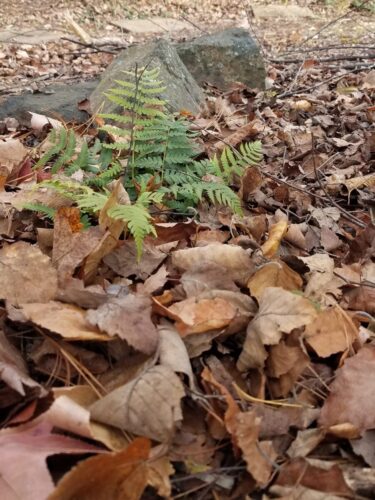Praise for Fallen Leaves
December 15, 2021 2:54 pm

By Ellen Powell, VDOF Conservation Education Coordinator
December is here – time to look forward to gifts, family visits, amazing food, and some welcome time off work. Raking leaves doesn’t rank very high on the December fun meter. But think of those fallen leaves as free mulch, there for the taking in this season of spending.
Maybe you think of mulch as the chopped wood chips or bark that comes in bags at your local home improvement store. But mulch can actually be any sort of material – organic or inorganic – that covers the soil, especially around the base of plants. Mulch has many benefits. It reduces weed competition, insulates the root zone against summer heat and winter cold, prevents water loss from the soil, provides a slow release of nutrients to plants, and reduces soil erosion. Mulch also creates habitat for the many tiny organisms that live in soil and decompose organic material. It provides overwintering and pupating spots for pollinators and other insects. It can even provide a source of wildlife food, as birds, reptiles, and amphibians forage for these hidden critters.
Growing up in eastern North Carolina, I was well acquainted with mulch, although we just called it pine straw. Every yard in my neighborhood had at least a few loblolly pines. Each fall, loads of pine needles fell like snipped hair all over the lawns. Neighborhood kids were sent out to rake up the pine straw, and with no curbside pickup for lawn waste, we had to do something else with it. The most common practice was to pile it around the very trees it fell from. In yards with lots of pines, we often extended the straw outward from the trees’ bases, connecting several trees in a contiguous bed. This resulted in large pine straw “islands” in the lawn. The bigger islands were often underplanted with a dogwood or two, along with the ever-popular Japanese azaleas.
It was years before I learned that what we were doing with our straw wasn’t mere laziness, but an ecologically-based practice called mulching. The woods behind our house consisted mostly of aging pines and maturing oaks. Underneath, the ground was spongy with a thick layer of pine straw and leaves. Under this litter layer was black, organic soil. The pine straw islands in our yards were just a re-creation of the forest floor, with the added benefit of reducing the amount of lawn we had to mow.
Here in Virginia, pine straw is a mulch option in some areas, particularly in the southeastern part of the state. But most everywhere else, leaves reign supreme in the free mulch category. They make excellent mulch for gardens, flower beds, and woodland edges. (Disclaimer: both pine straw and dry leaves are flammable, so consider the risks before using them around foundation plantings right next to your house.) Bear in mind that decomposing leaves create an acidic environment. This is fine for many shrubs, perennials, and even some vegetable crops. For plants that prefer more alkaline soils, lime can be used to raise the pH.
To use leaves as mulch, many people say you must shred them first. I can say with confidence that I have never found this to be necessary with the perennials in my landscape. By the time spring rolls around, weather and decomposition have flattened the leaves enough that new shoots poke through them easily. Plus, whole leaves make the best habitat for overwintering insects, from bumblebees to butterflies. However, if you do want to shred leaves, a mulching mower with a bag attachment makes it simple to collect and spread them.
- Leaf-mulched strawberries
- Leaves are perfect for a woodland garden.
To reduce lawn area or create woodland planting beds, try a process called sheet mulching. Simply lay down a thick layer of leaves and wait six months or so! I usually take an extra step to reduce future weed problems by smothering the grass first. To do this, lay down cardboard or several sheets of newspaper, wet it to keep it from blowing away, and pile the leaves on top. Both the paper and leaves will break down over time, adding additional organic matter to the soil.
Prefer to keep your lawn? Next year, starting when the leaves first fall, set your lawnmower blade at about three inches and mow over them once every week or so. The tiny pieces will disappear into the lawn, providing organic matter that benefits the grass.
Dead leaves can also become part of a healthy compost pile. There’s a bit of art and science to building one, but leaves provide the carbon-rich “browns” that are layered with nitrogen-rich “greens” to make the quickest compost.
What if you have dead limbs along with those leaves? Drag them to the back of your yard and make a brush pile for wildlife. It’s pretty easy to stack the limbs in such a way as to provide optimal space underneath for small mammals, reptiles, and amphibians.
Some people prefer to burn their leaves, but burning creates air quality issues and a wildfire risk, and it’s not legal in all areas. Other people bag their leaves and send them off to the landfill with the garbage. What a waste of good organic matter! This December, don’t burn or bag those leaves – leave them on your property instead. Leaf mulch is a seasonal gift your landscape will really appreciate.
Tags: Fall
Category: Education, Urban and Community Forestry


